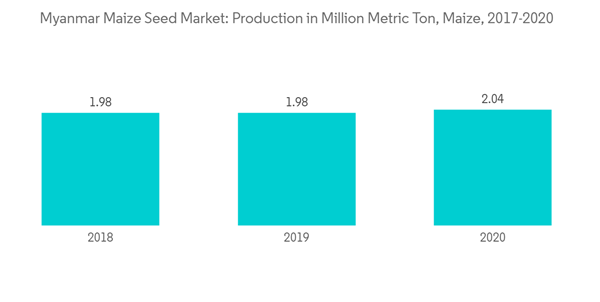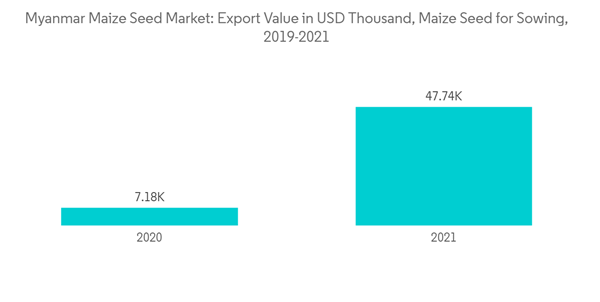Key Highlights
- Even though in terms of Myanmar's main crop production, it is renowned for its production of rice, sugar cane, and dry beans, among other vegetables, maize constitutes a significant cereal crop in the country. The collaboration of the Department of Agricultural Research of the Ministry of Agriculture, Livestock, and Irrigation with the International Maize and Wheat Improvement Center in turn favors the growth of hybrid maize production and eventually the seed market. Further, the increased production of maize and the rising demand from multiple industries, coupled with the growing export potential, drive the market in the country.
- Moreover, according to the survey conducted by the International Food Policy Research Institute in 2020, the number of maize growers in southern Shan, Myanmar, has tripled in the past 10 years, with larger landholdings being more likely to farm maize. Additionally, maize is by far the most important crop grown in the areas surveyed in terms of its contribution to cash incomes. Also, hybrid maize seed has been adopted widely in southern Shan and has been accompanied by big increases in fertilizer use.
- However, the restraints faced in the production of maize in the country have affected the maize seed market also. Maize prices have risen in 2021, according to the Yangon Region Chambers of Commerce and Industry. The rise in prices is attributed to steady foreign demand and the weakening of local currencies against the US dollar. The price stands at USD 310-330 per metric ton in the initial months of 2022, up from USD 250 in December 2021. The maize unrest has resulted in decreased exports from the country, which has subsequently impacted domestic production and, as a result, sowing seeds. Nevertheless, such restraints remain temporary, and the market is anticipated to grow steadily in the coming years.
Myanmar Maize Market Trends
Rising Domestic Production, and Multiple Industry Application of Maize
Maize accounts for a prominent cereal crop in the country. The main maize-producing areas in Myanmar are primarily found in the hilly and dry zones of the country, with smaller production taking place in the delta and coastal regions. According to official data from the Ministry, Shan State, which is located in the central part of the country, accounts for more than 50% of Myanmar's total maize production. Further, according to the agricultural statistics data from the Central Statistical Organization, maize production reached 2 million metric tons in 2020-21, an increase of 3% from the previous year. Furthermore, the area sown and harvested for maize has recently increased.As per the data from the Central Statistical Organization, the area harvested under maize has decreased by 7% in 2020-2021 from the past year and accounted for 1.37 million hectares in 2020-2021. In the country, 90% of farmers use hybrid seeds that are either purchased from commercial seed producers or provided by the government for commercial production.Moreover, maize has diverse uses in diverse industries, including the food and feed industries. Even though the major portion of the maize produced is utilized for human consumption, a significant share is utilized in the feed industry. According to the agricultural statistics data by the Central Statistical Organization, the maize utilized in animal feed accounted for 187 thousand metric tons in 2020-2021, an increase of 12% from the past two years. Thus, the demand from multiple industries across the country and the eventual increase in domestic production boost the growth of the market.
Growing Exports of Maize Seeds
Myanmar is a net exporter of maize. The maize is exported from the country as seeds for sowing and for other purposes, including cereal grains and feed grain. However, the majority of maize is used for non-seed purposes. Maize export supplies are normally delivered to Mandalay, the largest wholesale market in central Myanmar, and then subsequently transported for export to the northeastern border towns like Muse, Chin Shwe Haw, Lwejel, and Kan Paiktee.Further, the exports of maize have increased in recent years. According to UN Comtrade, the country's maize exports are expected to nearly double by 2021.Thailand, the Philippines, Vietnam, Bangladesh, and China constitute more than 90% of the total exported maize and are the major importers from the country. Additionally, nearly 68% of the exported maize seeds in Vietnam are utilized for sowing, and the country accounts for the third largest importer of maize seeds from the country.
Moreover, Chareun Phokphand carries out contract farming in the North and South Shan States. CP 888, which is produced and sold by the CP Group of Thailand, is the most commonly cultivated hybrid corn variety, followed by Yezin 6 and CP 868 varieties. The majority of this high-yielding hybrid (CP 888) is exported, with China occupying a majority share in the exports of maize from Myanmar.
Myanmar Maize Industry Overview
The maize seed market in Myanmar is highly concentrated. Charoen Pokphand is the largest player in the maize seed market in Myanmar, with a significant market share, and has also been the most active player in the market. Cortiva Agriscience, Groupe Limagrain, East-West Seed Myanmar Co Ltd, and Myanma Awba Group are among the market's other major players. Joint ventures with local companies and partnerships have been a strategy adopted by the players in the market. The government holds a small share of the maize seed market with Yezin hybrids.Additional Benefits:
- The market estimate (ME) sheet in Excel format
- 3 months of analyst support
This product will be delivered within 2 business days.
Table of Contents
Companies Mentioned (Partial List)
A selection of companies mentioned in this report includes, but is not limited to:
- Charoen Pokphand Group
- Corteva Agriscience
- East West Seed Myanmar Co Ltd
- Myanma Awba Group
- Groupe Limagrain
- Dagon Group
- KNOWN-YOU SEED CO,. LTD.
- Nongwoo Seed Myanmar Inc










